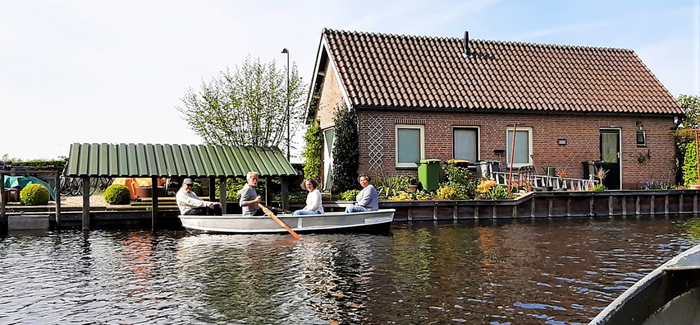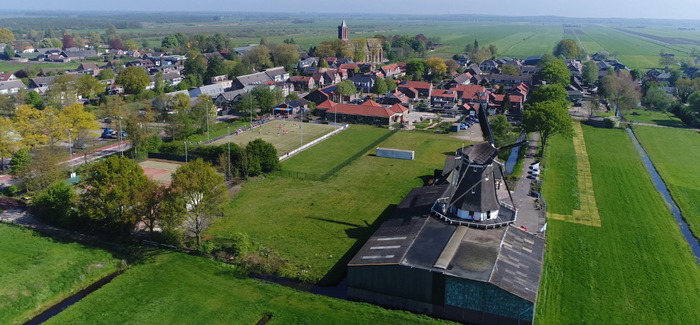Being Jewish
Feature
How a Dutch Farming Village Saved My Family From the Nazis

A petite woman with short gray hair and ruddy cheeks approaches me on the railway platform. This must be Karien, I think to myself, the local history buff who has volunteered to serve as my guide to Westbroek, a Dutch farming village where my mother, Doris Leopold Adler, and her family sought asylum from their native Germany in 1937.
Like many Holocaust survivors, my mother buried her early traumas, in part to focus on the future. Like many children of survivors, I have had an insistent need to uncover the past. But until now, I have known only the most basic contours of my mother’s childhood.
She was born in Bleichenbach, near Frankfurt, in 1936. Soon after, she, my grandparents, Irma and Willi Leopold, and seven other family members moved to Westbroek, seven miles north of Utrecht.
All were eventually deported to the Westerbork Transit Camp, but my 6-year-old mother and grandparents managed to escape.
After months on the run, they found a hiding place in the attic of a tiny house on the outskirts of Westbroek, and survived there from 1943 until the war’s end in 1945. The other family members were sent from Westerbork to Auschwitz and Sobibor, where they were murdered. In 1947, the three immigrated to the United States to join my grandmother’s family.
Now, more than 30 years after my mother’s passing, I have come to Westbroek with my husband, Alan, and three adult children, Alex, Ezra and Ma’ayan, to see if we can fill in the details.
When we arrive, our guide, Karien Scholten-Vredenbregt, and several interested villagers lead us to the top of a 15th-century church tower to take in the view. A ribbon of farmhouses stretches along a dike, interrupted only by the slow-turning sails of a windmill. A patchwork of fields and canals extends to the horizon. We descend and walk to a tidy brick house that was once my grandparents’ home and linen shop.
The current owners kindly show us the original building plans and the renovations the house has undergone since the store closed. Karien explains that as shopkeepers, my grandparents had a large network of acquaintances, and they proved crucial to evading the Nazis and their Dutch collaborators.
The next day we delve deeper. Karien has invited those who remember my family to meet at a local history museum. Theo Schouten, a compact, energetic 85-year-old, affectionately describes my mother’s big brown eyes. Jannie Leeflang-van der Vaart, also well into her 80s, tells us that she was my mother’s next-door neighbor. They went to school together and slept over at each other’s houses. She remembers the day my mother disappeared.
“None of us knew where Doris went,” Jannie tells us, though given the times, she adds, “we knew better than to ask.”
One memory stands out for Jannie from the time my mother and grandparents were in hiding. “One Sunday, my father insisted we change the usual route of our afternoon stroll” along the Nedereindse Canal, she recalls. “I learned only years later that he knew your family was hiding nearby and rerouted us to spare your mother the heartache of seeing her friends walking outside.”

Jannie hands me photographs of my mother that I have never seen before. Anneke Stekelenburg-van der Vaart, Jannie’s sister and another of my mother’s childhood friends, points to the necklace she is wearing—a gift my mother sent from America. Anita van Mourik, a middle-aged woman looking after her ailing mother, Lies van Mourik-Herrewijn, tells me through tears that they have made the hour-long trip from their home to Westbroek because her mother has something she wants to give me. Though suffering from dementia, Lies hasn’t forgotten my family.
Lies explains that before my mother and grandparents went into hiding, her parents would sometimes take them in overnight when there were Nazi raids. “After they were liberated,” she says, “your mother showed up with this gift from your grandparents’ store to say thank you.” She hands me a perfectly pressed damask tablecloth.
Emotions swirling, we bike to the most significant stop on our itinerary, the home of Marinus de Graaf, grandson of Marinus de Graaf and Wilhelmina de Graaf-Schouwburg, in whose 150-square-foot attic my mother and grandparents hid for more than two years. Rinus, as he is known, lives in the same remote canal-side location, though he has demolished and rebuilt the original house.
We get acquainted with Rinus and his wife, Fernanda, on their wooden deck, as light-dappled water drifts by.
Then we slip into a rowboat docked alongside the house, and Rinus rows us past the reeds into what is now a swampy nature reserve, just as his grandfather did for my family whenever Nazis scoured the area.
Back at the house, I present the de Graafs with a painting I commissioned from an artist friend in Jerusalem. Beneath an image of a symbolic family tree, the artist has inscribed the Talmudic saying, “Whoever saves a single life is considered to have saved the whole world,” in Hebrew and Dutch. Rinus and Fernanda are visibly moved.

After reluctant goodbyes, we head back to the village of Westbroek. Along the way, Karien calls to me from her bike.
“This is the spot where your mother and grandparents stopped to have their picture taken on their walk back to the village,” she says.
I recognize the bend in the road from a photograph I cherish, simply captioned “Liberation Day 1945.” I had not known it was taken as my mother and grandparents walked three miles from their hiding place back to town, from captivity to freedom.
As my husband and children huddle with me to replicate the image, I, too, feel a sense of freedom—the kind that comes from knowing. Now I know that my mother had a rich childhood with enduring friendships. I know how, where and because of whom she and her parents survived the war and were able to create a new life in America.
(My grandparents ran a chicken farm in Vineland, N.J., then operated a boarding house and managed a hotel in Atlantic City. My mother became a dietitian and married my father, Arthur Adler, in 1955. They settled in Bergenfield, N.J., and had three children: my brother, Steven; sister, Brenda; and me.)
I will never know the feeling of being forced to become invisible, or of re-emerging into the world traumatized. But I have closed a circle and, with the help of the kind residents of Westbroek, I have been able to bring together generations of my family at the bend in the road.
Since our visit in April 2022, Karien has continued her search to solve every remaining mystery of my mother’s story. Recently, she discovered that Jo Geurtsen-Boekstal, a friend of my grandparents whose photo hung in their Ventnor, N.J., home, made the lifesaving shidduch with the de Graafs; I hadn’t known how the two families came together.
Other residents of Westbroek have prepared written testimonies to support my request to Yad Vashem to have Marinus de Graaf and Wilhelmina de Graaf-Schouwburg officially recognized as “Righteous Among the Nations.”
And this past November, the village installed Stolpersteine—the brass plaques designed by German artist Gunter Demnig and embedded in front of the last homes in which Holocaust victims lived—to honor the memory of the 21 Jews of Westbroek murdered by the Nazis.
Seven are dedicated to members of my family.
Sheryl Abbey is a writer who made aliyah with her family in 1999. Her new poetry collection is Along the Edge of Absence.










 Facebook
Facebook Instagram
Instagram Twitter
Twitter
Michael says
Sheryl
It is wonderful to undertake the effort to get the family recognized. I helped my Dad recognize 2 families from Friesland. It’s and endeavor you will never regret.
Sheryl Abbey says
Thank you, Michael. Well done to you, too!
Roslyn Ross says
That was an amazing story of your family
Andrea Lamb Gaynor says
Sheryl, I knew your family from our synagogue in Bergenfield. I remember your mother as a very lovely woman, and I am happy to have learned about her story of survival.
Sheryl Abbey says
Thanks, Andrea. I remember you, too! Hope you and yours are well.
Marion Wiersch Blakeman says
Sheryl, I grew up in Vineland, NJ and my parents were friendly with your grandparents. It is by accident that I just read your article in the Hadassah Magazine and am speechless of the connection. I am 72 yrs old, but also raised on a chicken farm until my father had a heart attack in 1963. What a small world!
Sheryl Abbey says
Thank you for sharing that, Marion. It is, indeed, a small world.
Elaine Bierig says
Hi we also grew up in Vineland NJ before making Aliya in 1985. Our family immigrated from Edinfigen, Germany in1937 moving from New York to Norma New Jersey and then to Vinland New Jersey. The family also started with chicken farming and then to opening a kosher butcher shop.
It’s still in business today. It is run by tbe Bierig family. The family was very dedicated to educating the children in Jewish Days Schools in Vineland New Jersey
Sheryl Abbey says
Thank you for writing, Elaine. I never got to visit my grandparents in Vineland. By the time I was born, they had already moved to Atlantic City/Ventnor, NJ. But they always spoke fondly of their time there. it must have been a special community.